Four Player Khanhoo: A variant of Khanhoo is also sometimes played with four players, each playing independently. The game is played similarly to the two and three hand game. However, in this variant, the entire deck would be dealt out during the deal. Thus, after the first turn (in which the first player discards one card of his choice), each turn consists of simply drawing the card discarded by the previous player and then discarding any card of his choice from his hand.
As in the two and three player variant, another player can call "Bump" when it is not his own turn to claim the current top discard. If multiple players call "Bump", the player who indicates they can use the card in the highest point value meld has the option to take the card. Similarly, if the player who had the original right to take this card (because it is currently his own turn) wants the card, he may challenge the player
who initially called "Bump" for the card. The player who would be able to use the card in the highest point scoring meld is entitled to take the card. If the point values are tied, the player who would have his actual turn has the first right to the card. If none of the players who are challenging for the card are the player who had his turn temporarily interrupted, and the melds those players could make with the card of the same point value, the player who first called "Bump" has the right to take the discard.
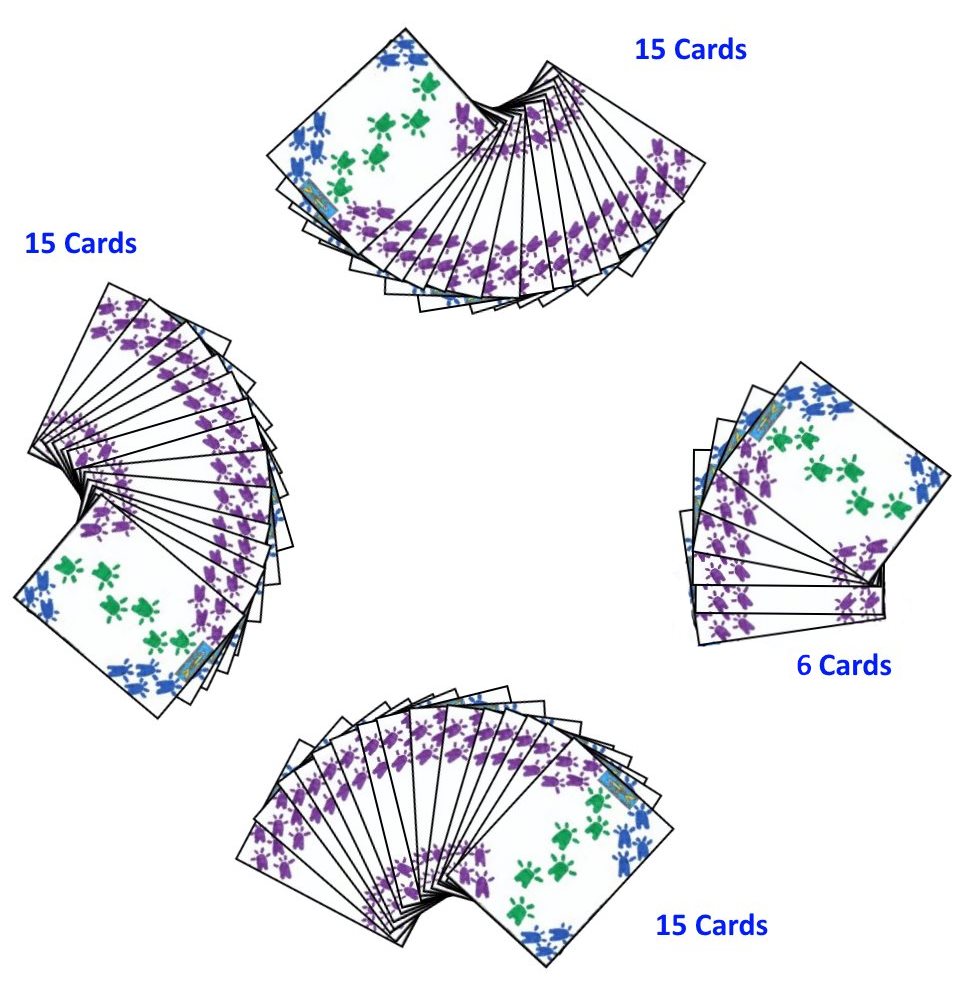
One other rule that is usually added with the four player variant is that one player may elect to play this hand at "orphan". Only one player during the hand has the option to play the hand at "orphan". To determine this, a draw is often done before the cards are initially dealt, and the player drawing the highest card is allowed this option on the current hand. If that player declines the option, no other player may elect to play as orphan that hand. This player must state that he wanst to play at "orphan" before the cards are dealt for this hand. If the player does elect to play "orphan" for the hand, he would receive only six cards in the initial deal and
would thus play out the hand using only six cards. If this player happens to also be the player to the immediate left of the current dealer, he would receive seven cards initially and then discard one card to end his first turn. In the case a player opts to play "orphan" during the hand, this will leave a few cards that can be used as a stock. In this case, the game proceeds as in the standard two and three hand version, with players normally drawing from the stock unless they can play the last discard immediately to a meld, at which time they can take this card.
In all other respects, this variant of the game is played identically to the standard version.
Double Pack Khanhoo: Another variant of Khanhoo is a version that is
played using an enlarged deck comprised of ninety total cards. This is the standard
Khanhoo deck as described above with the addition of one more card in
the suits of Diamonds, Clubs and Hearts in each of the ranks Ace, 2, 3, 4, 5, 6,
7, 8, 9. In addition, one additional Jack, Queen, and King is added in
the suit of Spades and one additional Joker is also added. These additions will allow up to eight total players to participate in a game.
The rules for this version of Khanhoo is identical to the standard version except for a few
differences. The first major difference is that, with the additional cards added, a number of new meld types can be created. Thus, the following chart shows the meld types possible in this game and the resulting score from melding them:
|
|
|
| Meld | Meld Description | Scoring Value |
|---|
| Sequence | Three or more cards in the same suit, in direct numerical sequence. May not include any Jacks, Kings or Queens. | 1 |
| Aces | Three Aces, two which must be of the same suit. | 1 |
| Triplet | Three cards of the same rank, each of a different suit. | 2 |
| Royal Assembly | Jack, Queen and King of Spades | 3 |
| Royal Group - Jack | Jack of Spades and two Diamond Sevens | 4 |
| Royal Group - Queen | Queen of Spades and two Club Eights | 4 |
| Royal Group - King | King of Spades and two Heart Nines | 4 |
| Khanhoo | Ace of Hearts, Two of Clubs, and Three of Diamonds | 5 |
| Double Triplet | Six Cards, all of the exact same rank | 10 |
| Double Aces | Six Aces of any Suits | 10 |
| Double Royal Assembly | Two Jacks, Two Queens, and Two Kings | 10 |
| Double Khanhoo | (Ace of Hearts) x 2, (Two of Clubs) x 2, (Three of Diamonds) x 2 | 15 |
| Triple Sequence | Nine cards all in the same suit | 3 |
| Triple Aces | Nine Aces, three of each suit | 6 |
| Triple Triplet | Nine cards all of the same rank, three in each suit | 9 |
| Triple Royal Assembly (also called Triple Courts) | Three Jacks, three Queens, and three Kings, all in Spades | 12 |
| Reverse Group - Jacks | Two Spade Jacks and one Diamond Seven | 4 |
| Reverse Group - Queens | Two Spade Queens and one Club Eight | 4 |
| Reverse Group - Kings | Two Spade Kings and one Heart Nine | 4 |
| Jacks - Triple Sequence | Three Spade Jacks and one Diamond Seven | 8 |
| Queens - Triple Sequence | Three Spade Queens and one Club Eight | 8 |
| Kings - Triple Sequence | Three Spade Kings and one Heart Nine | 8 |
| Triple Khanhoo | (Ace of Hearts) x 3, (Two of Clubs) x 3, (Three of Diamonds) x 3 | 25 |
|
 |
| Double Khanhoo features a number of additional meld types due to the greater number of cards used for the game. These meld types include these Triple Sequences. |
In this version, the Orphan rule is also often added. The player who, during the draw for dealer, drew the highest card may opt on this hand to go Orphan. In that case, this player would receive only six cards during the hand. The player must announce his plan to play Orphan on the hand before he receives all his cards. A player will often opt to play with an Orphan hand such that they have a faster opportunity to be the first player to run out of cards (earning the five point bonus), although they will have fewer cards to attempt to earn high scoring melds.
In all other aspects this version of Khanhoo is played identically to the standard version as described above.
Kowah: Kowah is another Rummy type game which was originally played using special Chinese stick cards. However, as in Khanhoo, it has been adapted to allow play using standard English suited cards. This game is from the island of Java in Indonesia.
Kowah uses a similar deck as used in Khanhoo, with the only difference being
that in Kowah the Joker is removed. Two of these 60 card decks are then shuffled together making one large deck
consisting of 120 total cards. The ranking of the cards in this deck are also the same as in Khanhoo. In the suits of Diamonds, Clubs and Hearts, the ranking of the cards are (from high to low); 9, 8, 7, 6, 5, 4, 3, 2, Ace. In the suit of Spades, the ranking of the cards are as
follows (also shown in rank from high to low); King, Queen, Jack. The game is designed for play by two to four participants.
Determination of seating positions and first dealer can be performed in a variety of methods, with draw for high cards a method commonly used. The players would thus seat themselves at the table in the order of ranking of cards drawn. The player drawing the highest ranked card of all is set as the first dealer.
Thereafter, the winner of each game deals the cards for the next game.
Once the dealer has been determined he thoroughly shuffles the deck and offers it to the player at his right to cut. After the cut, the dealer deals 8 face-down cards to each player, one-at-a-time and in a counterclockwise direction. He then places the remainder of the deck face-down in the center of the table as the stock.
The player to the immediate left of the dealer has the first turn, with the turns continuing in a clockwise direction around the table. On the first turn of the game, since there is not yet a discard pile, this first player must draw the top card of the stock pile to start his turn. Thereafter, to start his turn, each player can opt to draw the top, face-up card of the discard pile or the top face-down card of the stock pile.
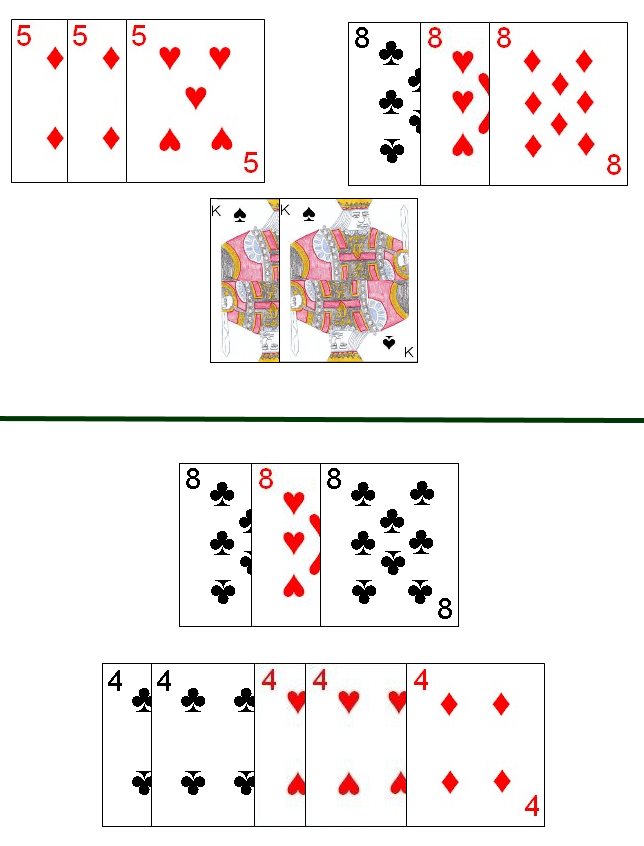
The object of each player is to create a special combination of cards in the hand and meld some of the cards making up that meld on the table. This will allow the player to declare "checki", giving that player special privileges during the hand. The combinations which a player attempts to make, allowing him to declare "checki" are as follows:
- Two sets of Three cards of the same rank:
This consists of a combination of three cards of the exact same rank, and another set of three cards of the same rank. The suits of the cards in
each three of a kind is irrelevant. In addition, the player must also have two additional cards
which are of the same suit and rank.
- Three of a Kind and a Double Pair:
This combination consists of a set
of three cards all of the same rank (suit does not matter), and then five cards
all of the same rank. However, this five of a kind must be comprised in a
specific way. If must consist of a pair of cards of the same rank and suit, a
second pair of cards of that same rank and of the same suit (but of a different suit than the first pair), and then a fifth card of that same rank and still another suit.
Once a player, during his turn is able to make one of these two combinations in his hand, he declares "checki". When declaring "checki" the player must place
some of the cards from his melds face-down on the table in front of
himself. For the first type of meld he places the pair of identical cards on the table and for the second type of meld he places the identical pairs on the table as well as the single card which is of that same suit. Although these cards are melded on the table, they are still considered to be part of that player's hand.
Once any player has declared "checki" each other player (whether that player has also declared "checki" during the hand or not), if drawing
a card from the face-down stock pile on his turn, must show the card he
draws. If this card matches, in suit and rank, any of the two identical cards the player has melded on the table in front of himself, he is entitled to immediately claim that card,
regardless of the fact that it may not even be the claiming player's
turn. Similarly, if another player discards such a card at the end of
his turn, a player who called "checki" can immediately, even out of turn, claim this card
if the card is an exact match (suit and rank) for the cards in the
identical pairs he has melded in front of himself. When this occurs, with the player claiming the card, the hand immediately ends with that player immediately declared the winner of the game. If more than one player wants to claim such a card, the player closest in rotation to the player making the discard is entitled to that card.
If a player wins the hand by claiming a card drawn by an opponent,
he is said to win a single game. If a player wins the hand by claiming the
discard, he is said to win a double game, and if he wins by drawing his
needed card directly on his turn from the draw pile, he is considered to
have won a triple game.
If the last card from the stock pile is taken and the player who draws that card is unable to win the game on his turn, the game ends in a draw or tie, with no winner and the same dealer dealing the next hand.
Copyright © 2015 CatsAtCards.com. All rights reserved.
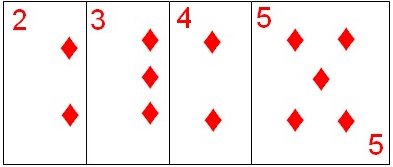
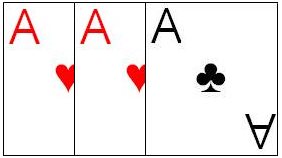
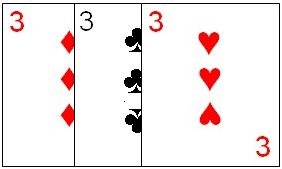
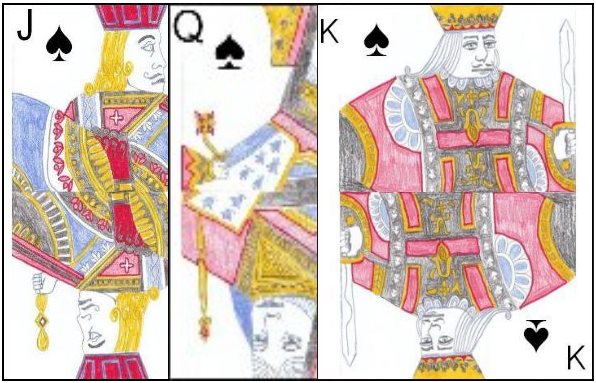
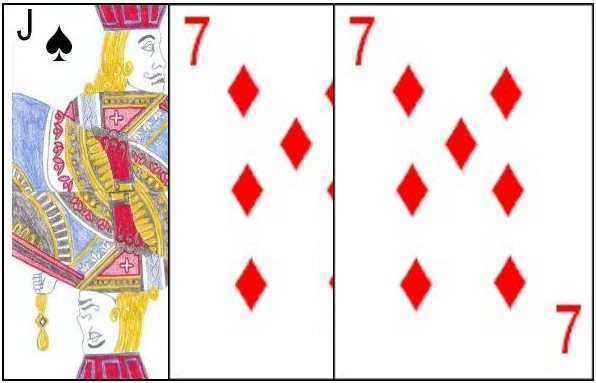
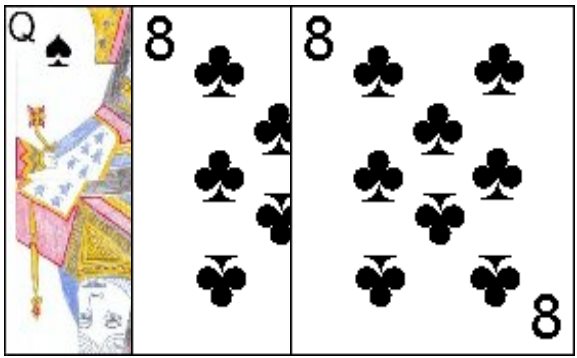
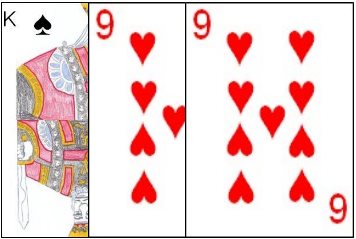
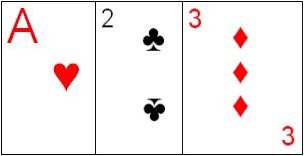
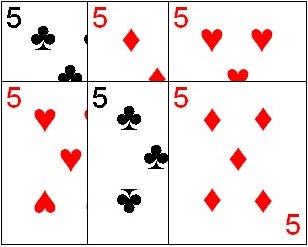
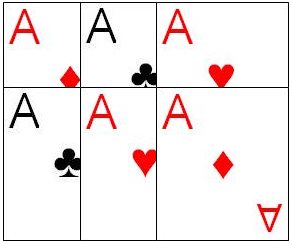
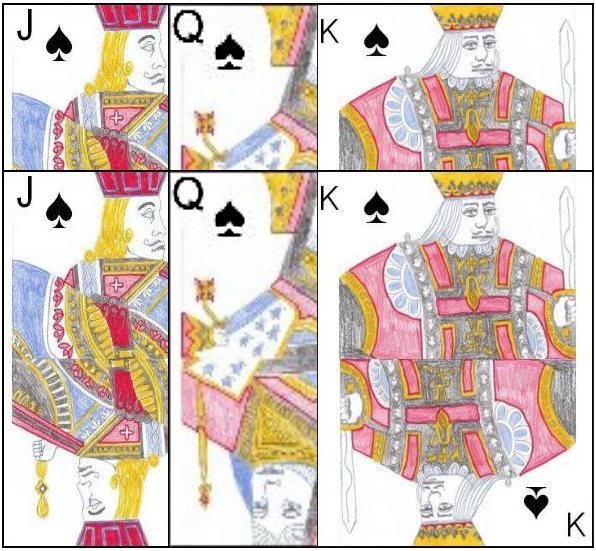
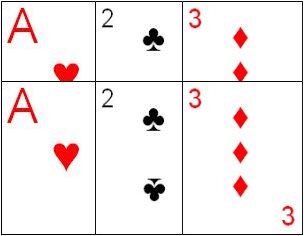
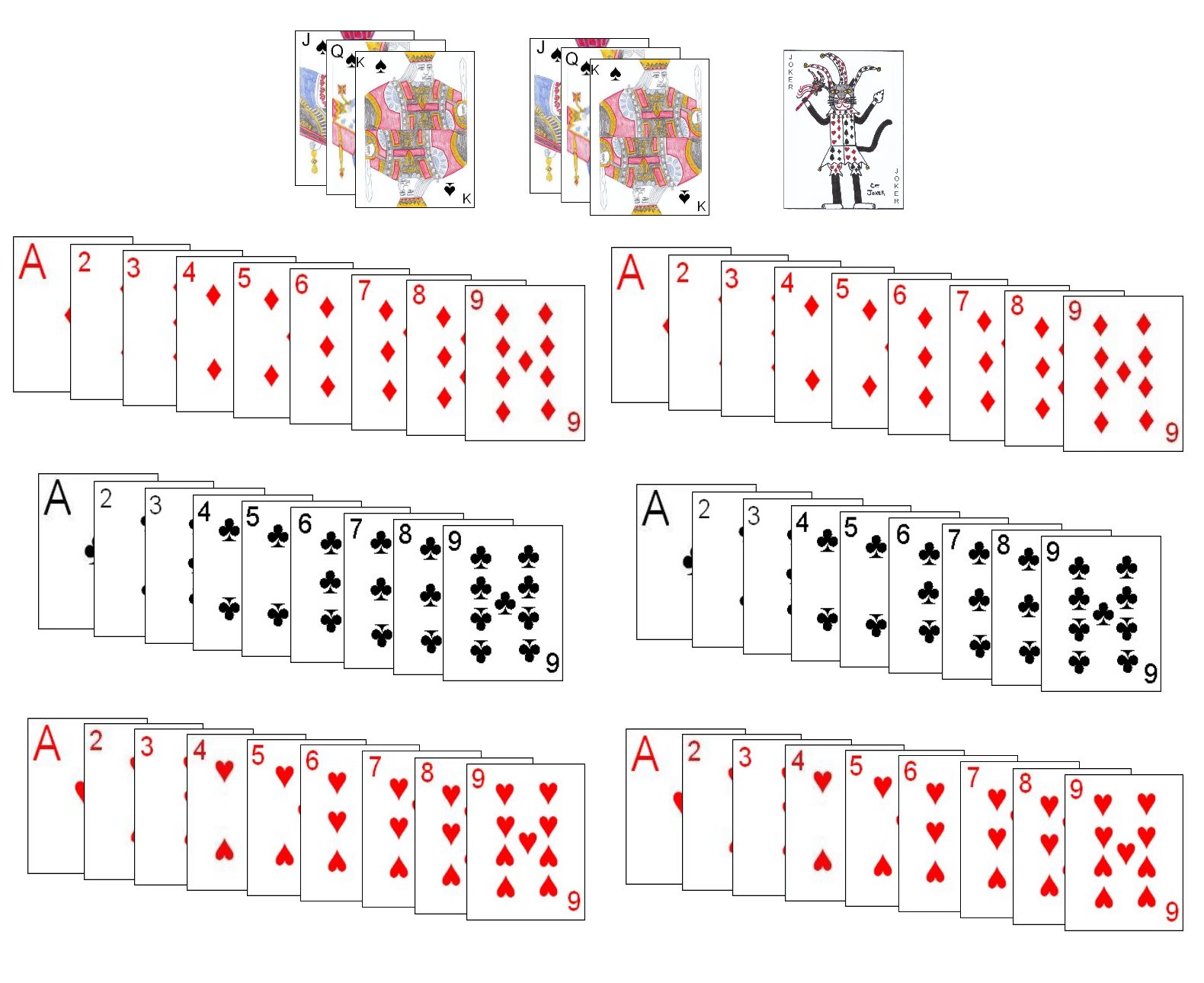 In China the game is traditionally played with special kun p'ai (or stick) cards. However, with the modifications introduced by Wilkinson, the deck to be used in playing Khanhoo can also be created by combining two standard 52 card decks and removing certain cards from the deck that will not be used in play. Thus, to form this deck, the following cards should be included from two standard decks; Jack, Queen and King of Spades, and all 2's through 9's from the other three suits (Clubs, Hearts and Diamonds). In addition, one Joker should be added to the deck, creating a deck consisting of exactly 61 cards total. The Jack, Queen, and King of Spades are special cards, with no relative ranking. However, the sequence ranking of the cards in the other suits is as follows (high to low); 9, 8, 7, 6, 5, 4, 3, 2, Ace.
In China the game is traditionally played with special kun p'ai (or stick) cards. However, with the modifications introduced by Wilkinson, the deck to be used in playing Khanhoo can also be created by combining two standard 52 card decks and removing certain cards from the deck that will not be used in play. Thus, to form this deck, the following cards should be included from two standard decks; Jack, Queen and King of Spades, and all 2's through 9's from the other three suits (Clubs, Hearts and Diamonds). In addition, one Joker should be added to the deck, creating a deck consisting of exactly 61 cards total. The Jack, Queen, and King of Spades are special cards, with no relative ranking. However, the sequence ranking of the cards in the other suits is as follows (high to low); 9, 8, 7, 6, 5, 4, 3, 2, Ace.












 One other rule that is usually added with the four player variant is that one player may elect to play this hand at "orphan". Only one player during the hand has the option to play the hand at "orphan". To determine this, a draw is often done before the cards are initially dealt, and the player drawing the highest card is allowed this option on the current hand. If that player declines the option, no other player may elect to play as orphan that hand. This player must state that he wanst to play at "orphan" before the cards are dealt for this hand. If the player does elect to play "orphan" for the hand, he would receive only six cards in the initial deal and
would thus play out the hand using only six cards. If this player happens to also be the player to the immediate left of the current dealer, he would receive seven cards initially and then discard one card to end his first turn. In the case a player opts to play "orphan" during the hand, this will leave a few cards that can be used as a stock. In this case, the game proceeds as in the standard two and three hand version, with players normally drawing from the stock unless they can play the last discard immediately to a meld, at which time they can take this card.
One other rule that is usually added with the four player variant is that one player may elect to play this hand at "orphan". Only one player during the hand has the option to play the hand at "orphan". To determine this, a draw is often done before the cards are initially dealt, and the player drawing the highest card is allowed this option on the current hand. If that player declines the option, no other player may elect to play as orphan that hand. This player must state that he wanst to play at "orphan" before the cards are dealt for this hand. If the player does elect to play "orphan" for the hand, he would receive only six cards in the initial deal and
would thus play out the hand using only six cards. If this player happens to also be the player to the immediate left of the current dealer, he would receive seven cards initially and then discard one card to end his first turn. In the case a player opts to play "orphan" during the hand, this will leave a few cards that can be used as a stock. In this case, the game proceeds as in the standard two and three hand version, with players normally drawing from the stock unless they can play the last discard immediately to a meld, at which time they can take this card.

 The object of each player is to create a special combination of cards in the hand and meld some of the cards making up that meld on the table. This will allow the player to declare "checki", giving that player special privileges during the hand. The combinations which a player attempts to make, allowing him to declare "checki" are as follows:
The object of each player is to create a special combination of cards in the hand and meld some of the cards making up that meld on the table. This will allow the player to declare "checki", giving that player special privileges during the hand. The combinations which a player attempts to make, allowing him to declare "checki" are as follows: